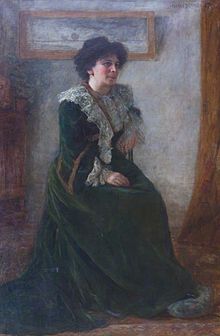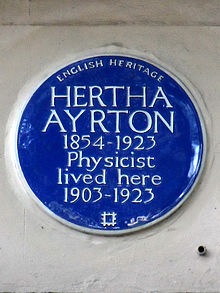Mathematics and electrical engineering work
Upon her return to London, Ayrton earned money by teaching and embroidery, ran a club for working girls, and cared for her invalid sister. She also put her mathematical skills to practical use – she taught at Notting Hill and Ealing High School, and was also active in devising and solving mathematical problems, many of which were published in "Mathematical Questions and Their Solutions" from the Educational Times. In 1884 Ayrton patented a line-divider, an engineering drawing instrument for dividing a line into any number of equal parts and for enlarging and reducing figures. The line-divider was her first major invention and, while its primary use was likely for artists for enlarging and diminishing, it was also useful to architects and engineers. Ayrton's patent application was financially supported by Louisa Goldsmid and feminist Barbara Bodichon, who together advanced her enough money to take out patents; the invention was shown at the Exhibition of Women's Industries and received much press attention. Ayrton's 1884 patent was the first of many – from 1884 until her death, Hertha registered 26 patents: five on mathematical dividers, 13 on arc lamps and electrodes, the rest on the propulsion of air.
In 1884 Ayrton began attending evening classes on electricity at Finsbury Technical College, delivered by Professor William Edward Ayrton, a pioneer in electrical engineering and physics education and a fellow of the Royal Society. On 6 May 1885 she married her former teacher, and thereafter assisted him with experiments in physics and electricity. She also began her own investigation into the characteristics of the electric arc.
In the late nineteenth century, electric arc lighting was in wide use for public lighting. The tendency of electric arcs to flicker and hiss was a major problem. In 1895, Hertha Ayrton wrote a series of articles for the Electrician, explaining that these phenomena were the result of oxygen coming into contact with the carbon rods used to create the arc. In 1899, she was the first woman ever to read her own paper before the Institution of Electrical Engineers (IEE). Her paper was entitled "The Hissing of the Electric Arc". Shortly thereafter, Ayrton was elected the first female member of the IEE; the next woman to be admitted to the IEE was Dorothy Smith in 1958. She petitioned to present a paper before the Royal Society but was not allowed because of her sex and "The Mechanism of the Electric Arc" was read by John Perry in her stead in 1901. Ayrton was also the first woman to win a prize from the Society, the Hughes Medal, awarded to her in 1906 in honour of her research on the motion of ripples in sand and water and her work on the electric arc. By the late nineteenth century, Ayrton's work in the field of electrical engineering was recognised more widely, domestically and internationally. At the International Congress of Women held in London in 1899, she presided over the physical science section. Ayrton also spoke at the International Electrical Congress in Paris in 1900. Her success there led the British Association for the Advancement of Science to allow women to serve on general and sectional committees. In a history of housework in the British Isles, Caroline Davidson called Ayrton one of the rare "female electrophiles" who contributed to the advancement of electricity in ways that transformed women's labor within homes.
In 1902, Ayrton published The Electric Arc, a summary of her research and work on the electric arc, with origins in her earlier articles from the Electrician published between 1895 and 1896. With this publication, her contribution to the field of electrical engineering began to be cemented. However, initially at least, Ayrton was not well received by the more prestigious and traditional scientific societies such as the Royal Society. In the aftermath of the publication of The Electric Arc, Ayrton was proposed as a Fellow of the Royal Society by renowned electrical engineer John Perry in 1902. Her application was turned down by the Council of the Royal Society, who decreed that married women were not eligible to be Fellows. However, in 1904, she became the first woman to read a paper before the Royal Society when she was allowed to read her paper "The Origin and Growth of Ripple Marks" and this was later published in the Proceedings of the Royal Society. In 1906, she was awarded the Royal Society's prestigious Hughes Medal "for her experimental investigations on the electric arc, and also on sand ripples." She was the fifth recipient of this prize, awarded annually since 1902, in recognition of an original discovery in the physical sciences, particularly electricity and magnetism or their applications, and as of 2018, one of only two women so honoured, the other being Michele Dougherty in 2008.

